
- Subject:
- Social Science
- Sociology
- Material Type:
- Unit of Study
- Provider:
- Rice University
- Provider Set:
- OpenStax College


Define and describe the scientific methodExplain how the scientific method is used in sociological researchUnderstand the function and importance of an interpretive frameworkDefine what reliability and validity mean in a research study

In this course, we will explore what makes things in the world the way they are and why, to understand the science and consider the engineering. We learn not only why the physical world behaves the way it does, but also how to think with chemical intuition, which can’t be gained simply by observing the macroscopic world.
This 2018 version of 3.091 by Jeffrey Grossman and the 2010 OCW version by Don Sadoway cover similar topics and both provide complete learning materials. This 2018 version also includes Jeffrey Grossman’s innovative Goodie Bags, Why This Matters, and CHEMATLAS content, as well as additional practice problems, quizzes, and exams.

Introduction to experiment design. Creating a hypothesis. Double-blind testing. Placebo effect.

This is a laboratory manual designed for an Introductory Biology Course. Topics covered include Data and Literature, Basic Scientific Skills, the Scientific Method, Macromolecules, Diffiusion and Osmosis, Enzymes, Microscopes and Cells, Cellular Respiration and Photosynthesis, The Cell Cycle, Mitosis and Meiosis, Genetics and DNA Fingerprinting. Each lab has a pre-laboratory assignment and post-laboratory assignment for students to complete. Additional resources referenced in the lab are provided, as well as grading rubrics for every assignment and a Lab Instructor Manual that contains lab notes and results from the lab exercises. A recipe list for all reagents is also included.

A short in-class exercise to help introductory biology students apply the scientific method
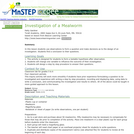
This activity is based on observations of mealworms form a question and make decisions as to the design of an investagation. Students use data collected to make a conclusion to their questions.
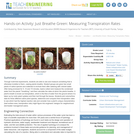
Through multi-trial experiments, students are able to see and measure something that is otherwise invisible to them seeing plants breathe. Student groups are given two small plants of native species and materials to enclose them after watering with colored water. After being enclosed for 5, 10 and 15 minutes, teams collect and measure the condensed water from the plants' "breathing," and then calculate the rates at which the plants breathe. A plant's breath is known as transpiration, which is the flow of water from the ground where it is taken up by roots (plant uptake) and then lost through the leaves. Students plot volume/time data for three different native plant species, determine and compare their transpiration rates to see which had the highest reaction rate and consider how a plant's unique characteristics (leaf surface area, transpiration rate) might figure into engineers' designs for neighborhood stormwater management plans.
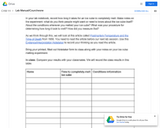
Lab Manual.

Students gain first-hand experience with the steps of the scientific method as well as the overarching engineering design process as they conduct lab research with the aim to create a bioplastic with certain properties. Students learn about the light mechanism that causes ultraviolet bead color change, observe the effect of different light waves on a phosphorescence powder, and see the connection between florescence, phosphorescence and wavelength. Students compose hypotheses and determine experimental procedure details, as teams engineer variations on a bioplastic solid embedded with phosphorescence powder. The objective is to make a structurally sound bioplastic without reducing its glowing properties from the powder embedded within its matrix. Groups conduct qualitative and quantitative analyses of their engineered plastics, then recap and communicate their experiment conclusions in the form of a poster, slides and verbal presentation. As an extension, teams make their own testing apparatuses. As a further extension, they combine all the group results to determine which bioplastic matrix best achieves the desired properties and then “manufacture” the optimum bioplastic into glowing toy figurine end products! Many handouts, instructions, photos and rubrics are provided.
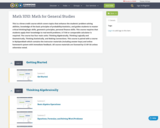
This is a three-credit course which covers topics that enhance the students’ problem solving abilities, knowledge of the basic principles of probability/statistics, and guides students to master critical thinking/logic skills, geometric principles, personal finance skills. This course requires that students apply their knowledge to real-world problems. A TI-84 or comparable calculator is required. The course has four main units: Thinking Algebraically, Thinking Logically and Geometrically, Thinking Statistically, and Making Connections. This course is paired with a course in MyOpenMath which contains the instructor materials (including answer keys) and online homework system with immediate feedback. All course materials are licensed by CC-BY-SA unless otherwise noted.
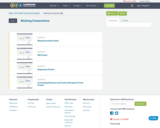

In this project, students will have the opportunity to explore how math is used to solve real-world problems. In this case, students will examine how linear equations may be used to predict the size of megalodon based on the size and position of a fossilized tooth. You may have students work individually or as part of a team (3-4 would be ideal).

In MedMyst: Disease Defenders, players can choose to train with an epidemiologist, microbiologist, or veterinarian to learn how these experts work as a team to solve infectious disease outbreaks while using the scientific method. Each expert path has its own learning objectives and stresses different parts of the scientific method.
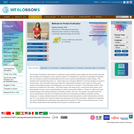
This Protein Purification video lesson is intended to give students some insight into the process and tools that scientists and engineers use to explore proteins. It is designed to extend the knowledge of students who are already somewhat sophisticated and who have a good understanding of basic biology. The question that motivates this lesson is, ''what makes two cell types different?'' and this question is posed in several ways. Such scientific reasoning raises the experimental question: how could you study just a subset of specialized proteins that distinguish one cell type from another? Two techniques useful in this regard are considered in the lesson.
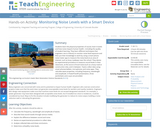
Students learn the physical properties of sound, how it travels and how noise impacts human health—including the quality of student learning. They learn different techniques that engineers use in industry to monitor noise level exposure and then put their knowledge to work by using a smart phone noise meter app to measure the noise level at an area of interest, such as busy roadways near the school. They devise an experimental procedure to measure sound levels in their classroom, at the source of loud noise (such as a busy road or construction site), and in between. Teams collect data using smart phones/tablets, microphones and noise apps. They calculate wave properties, including frequency, wavelength and amplitude. A PowerPoint® presentation, three worksheets and a quiz are provided.
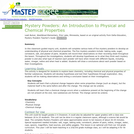
In this classroom guided inquiry lesson, students will complete a serious of tests using five different mystery powders. Student will develop hypotheses, make observations, and draw conclusions about what each powder is and the physical and chemical reactions that occur when heat, water, iodine, and vinegar are added to each substance.
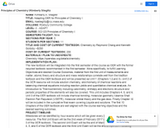
Principles of Chemistry I and II and Lab (SCI123 and SCI124), fulfills the chemistry requirement of biology, pharmacy, premed, prevet, engineering, or chemistry majors. It is expected that the student will go on to the second semester of this sequence Principles of Chemistry II (SCI124) or equivalent; SCI123 is not designed to be a one semester introductory course. This course is generally viewed as a science major introductory chemistry class. If your intended program of study is a physical science, pharmacy, pre-med/pre-vet, or engineering major this course is required. Laboratory work serves to reinforce concepts as well as introduce students to the scientific method, basic laboratory techniques, and the importance of safety in the laboratory environment.

Psychology is designed to meet scope and sequence requirements for the single-semester introduction to psychology course. The book offers a comprehensive treatment of core concepts, grounded in both classic studies and current and emerging research. The text also includes coverage of the DSM-5 in examinations of psychological disorders. Psychology incorporates discussions that reflect the diversity within the discipline, as well as the diversity of cultures and communities across the globe.Senior Contributing AuthorsRose M. Spielman, Formerly of Quinnipiac UniversityContributing AuthorsKathryn Dumper, Bainbridge State CollegeWilliam Jenkins, Mercer UniversityArlene Lacombe, Saint Joseph's UniversityMarilyn Lovett, Livingstone CollegeMarion Perlmutter, University of Michigan
